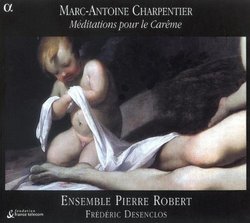| All Artists: Marc-Antoine Charpentier, Ensemble Pierre Robert, Frederic Desenclos, Marcel Beekman, Robert Getchell, Robbert Muuse Title: Charpentier: Meditations pour le Careme /Ensemble Pierre Robert * Desenclos Members Wishing: 0 Total Copies: 0 Label: ALPHA PRODUCTIONS Original Release Date: 1/1/2006 Re-Release Date: 5/9/2006 Album Type: Import Genres: Special Interest, Classical Styles: Opera & Classical Vocal, Historical Periods, Baroque (c.1600-1750), Instruments, Keyboard, Symphonies Number of Discs: 1 SwapaCD Credits: 1 UPC: 3760014190919 |
Search - Marc-Antoine Charpentier, Ensemble Pierre Robert, Frederic Desenclos :: Charpentier: Meditations pour le Careme /Ensemble Pierre Robert * Desenclos
 | Marc-Antoine Charpentier, Ensemble Pierre Robert, Frederic Desenclos Charpentier: Meditations pour le Careme /Ensemble Pierre Robert * Desenclos Genres: Special Interest, Classical
|
Larger Image |
CD Details |
CD ReviewsA dramatic and rich work commemorating the passion of Christ Eddie Konczal | 04/05/2007 (5 out of 5 stars) "The works of Marc-Antoine Charpentier (1643 - 1704) represent a revival of the grand tradition of French sacred music. The land that produced such giants of church music such as Leonin, Perotin, Machaut, and Dufay began to wane in importance during the mid-Renaissance. During the 16th and 17th centuries, France's prominence in sacred music was eclipsed by Italy (Palestrina, Monteverdi, and Carissimi), England (Byrd and Tallis), Spain (Morales and Victoria) and, finally, Germany (Schein, Scheidt and Schutz), where the tradition would culminate in the late Baroque period with the works of J. S. Bach.
Charpentier's sacred works were not influenced by his French predecessors, but by Giacomo Carissimi, an Italian composer of the early Baroque period who pioneered the oratorio form. Oratorios are essentially religious dramas set to music, performed without staging or costumes in churches or other religious settings - the most famous example being Handel's "Messiah," another culmination of the Baroque era. Carissimi's influence is strongly felt in Charpentier, especially these "Meditations pour la Careme (Meditations for Lent)," a dramatic and rich work commemorating the passion of Christ. The Meditations do not actually constitute oratorio, but rather a series of "petit motets," musical settings of Latin texts to be performed with a small ensemble. The term "motet" signifies an older polyphonic form dating back to the late Middle Ages, and indeed Charpentier is clearly working within a well-established tradition. However, Charpentier incorporates distinctly Baroque elements, such as continuo, recitative, and arioso, thereby taking advantage of newer musical grammar to reach new levels of expressiveness in sacred music. This recording, presented by Ensemble Pierre Robert, is nothing short of sublime. The singers (Marcel Beekman, Robert Getchell, and Robert Muuse) brilliantly convey the emotions present in Charpentier's setting of the Passion. The instrumentalists (violist Florence Bolton, theorbo player Benjamin Perrot, bassoonist Alexandre Salles, and organist Frederic Desenclos) play with stately and understated grandeur. The beautiful packaging includes a color reproduction and insightful discussion of Lubin Baugin's painting "Christ at the tomb." "Meditations pour la Careme" is a gift for lovers of sacred Baroque music, and I cherish the prospect of listening to it as part of my Lenten observances. " |

 Track Listings (18) - Disc #1
Track Listings (18) - Disc #1